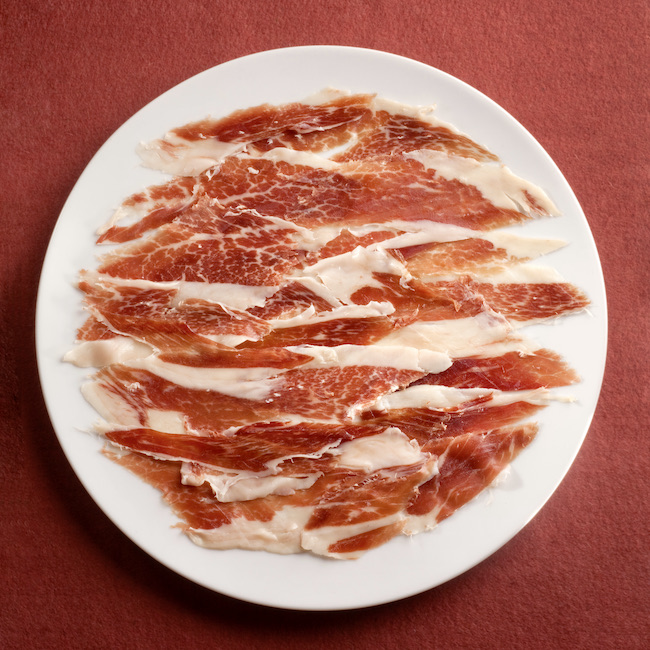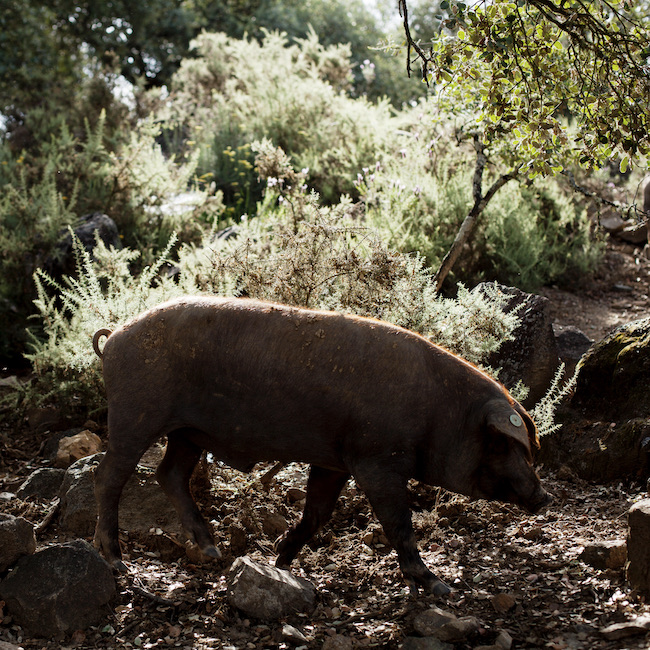by Simon Hunter - @simoninmadrid
.png.transform/rendition-xs/image_image%20(1).png)
Some of the most famed producers in Spain select hams from truly exceptional years: this is the story of the exclusive jamones de añada.

by Simon Hunter - @simoninmadrid
Spain’s bellota hams are synonymous with quality. To qualify for the black tag that denotes that a jamón is the best of the best, there are a series of stringent conditions that must be met – from the breed of the pig itself, to its diet before it is slaughtered. But for the last few decades the gourmet consumer has had an even higher-quality option: jamón de añada, or vintage ham. Some of the country’s most famed producers regularly select legs that have come from truly exceptional years, and sell them as special editions.
But before we can establish what sets a vintage ham apart from the rest, it is important to understand the life cycle of the Iberian pig. These animals are first reared on their mothers milk, before they are fed with a fibre-rich feed that helps them develop strong muscles and bones. Then it is time for them to fatten up, feeding almost exclusively on acorns, or bellotas, which is where they get their name.
Pigs from Joselito, one of Spain’s leading ham brands, live their entire lives in their natural habitat, and enjoy some three hectares of land each. This pasture is known as the dehesa, and the feeding period here is called the montanera.

The importance of ‘montanera’
During the montanera, which takes place during the final months of one year and the beginning of the next, the pigs can eat as many as seven kilos of acorns and three kilos of grass in a single day. It is the variations in the conditions during this time that set one year apart from the other, followed by the carefully monitored curing process.
“We currently have hams that have been naturally cured for more than 15 years,” explains José Gómez Sánchez, brand manager at Joselito. “Each vintage ham from Joselito is unique and different. The characteristics are closely linked to the weather conditions. The vintage from a very dry, hot year has different characteristics and leads to a different flavour compared to a cold year with a lot of rain.”
For example, cool temperatures and humid conditions lead to a softer texture, as well as a more subtle aroma. Then there are the bellotas themselves. The acorns can fall from the oaks at different times, and there can be varying quantities and types of the nuts for the animals to feast on.
“It all depends on the dehesa,” explains Eva Sánchez, one of the owners of another leading ham company, Fisan. “Has there been more water, less water, did the acorns fall sooner or later… all of that contributes to the añadas being different. It’s very similar to wine, because we also depend on the climatological conditions.”
At Fisan, the animals are sacrificed during the months of January, February and March. Although they will have been feeding in the dehesa during the latter part of the previous year, the vintage refers to the year they are sacrificed. And then, of course, comes another key part to creating a spectacular ham: the production.

A matter of patience
“The añada can be great, but you have to know how to produce them,” Eva explains. “If you don’t take the optimum care during the elaboration process, the ham will be spoiled. The salting, the drying, the curing, temperature, humidity… All of those things are where the ham is created, and it takes a lot of patience.”
The first of the Fisan limited edition añada hams are ready to be sold some 36 to 38 months after the animal is slaughtered. “These are the ones that weigh less, because they cure faster,” says Eva. “But some of them are cured for as long as 60 months.”
So which has been the best añada of all time for the two companies? “It’s very difficult to say, because it depends on tiny nuances,” explains José. “But if we were to pick an exceptional vintage, it would be 2005. It was a year when the climate conditions were perfect in the countryside, with a lot of acorns. I’d be hard pressed to remember another year like that.”
“The 2014 añada was very good,” adds Eva. “The climate was perfect, the quantity and size of the acorns was just right, it rained at the right time for the acorns to fall, the pigs entered the dehesa at the end of October, so they could roam…”
For anyone wanting to sample that vintage, there’s some bad news: it has sold out. There are, however, other options. The 2017 and 2018 añadas from Fisan are both available – providing, of course, you are willing to hand over the not inconsiderable sum of €1,200 for a single leg. But that is a small price to pay for a chance to sample one of the finest-quality products Spain has to offer.